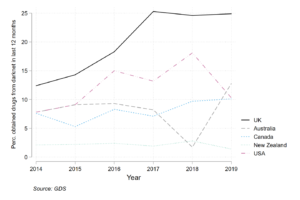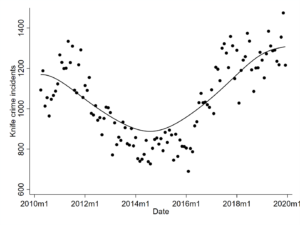In short, our working thesis is that the rise in knife crime – particularly prevalent since 2015 – might in part be driven by technological change. You might wonder how the two are possibly related?!
The argument we make, as captured in BIT’s report for the Mayor of London’s Violence Reduction Unit, is that British consumers were leading globally in switching their drug purchases to buying drugs online, namely the Dark Net. We base our hypothesis on data collected by the Global Drug Survey that shows that for the UK the fraction of drug users that purchased their drugs online has increased by about 25%. We think it’s fair to assume that the switch was more pronounced in and around London.
Percentage of users who obtained drugs from the darknet in the last 12 months

Data from the Global Drug Survey.
This means it’s likely that the drug market on the streets of London was shrinking as consumers switched online, leading to contested markets. Gangs that sell drugs on the street market might respond to this ‘income shock’ by trying to expand their local territory through violence using knives – their only widely accessible weapon in the UK. They might also expand into new markets by selling drugs outside of London – expanding their ‘county lines’.
This hypothesis is supported by data on knife crimes (see Figure 1A). After a long decline in knife crime incidents, we see a drastic increase towards the end of 2015, which aligns with the timing of the drastic switch to the Dark Net.
Monthly knife crimes in London between 2011 and 2019

Dots show monthly average knife crimes across London. The line shows the locally weighted regression of those averages over time. Data from the Met Crime Data Dashboard.
So what can the police do about this? We wanted to see if disrupting gangs could have a (long-lasting) impact on the levels of knife crime in an area. To do this, we identified a joint operation by the National Crime Agency and the Met Police between July and October 2017 that resulted in a gang called the Thatch House Thugs from Waltham Forest being disrupted.
Using a robust difference-in-differences model we can show that knife crime with injury decreased by 15 per cent after the operation over the long run, relative to the other wards in the borough. This suggests that disrupting these gangs is a credible knife reduction strategy (Kirchmaier, Machin and Villa-Llera, 2020).
Prof Tom Kirchmaier is a Visiting Senior Fellow at the Centre for Economic Performance at the LSE focusing on understanding the various aspects of crime and policing. This short blog is a teaser for a working paper by Tom, along with Steve Machin, Carmen Villa-Llera.
References
Bindler, A, and R Hjalmarsson (2018) ‘The Impact of the First Professional Police Forces on Crime’, working paper.
Draca, M, S Machin and R Witt (2011) ‘Panic on the streets of London: Police, crime, and the July 2005 terror attacks’, American Economic Review 101(5): 2157-81.
Kirchmaier, T, S Machin and C Villa-Llera (2020), ‘Gangs and Knife Crime in London, Available at SSRN here.
Levitt, S (1997) ‘Using electoral cycles in police hiring to estimate the effect of police on crime’, American Economic Review 87: 270-90.




